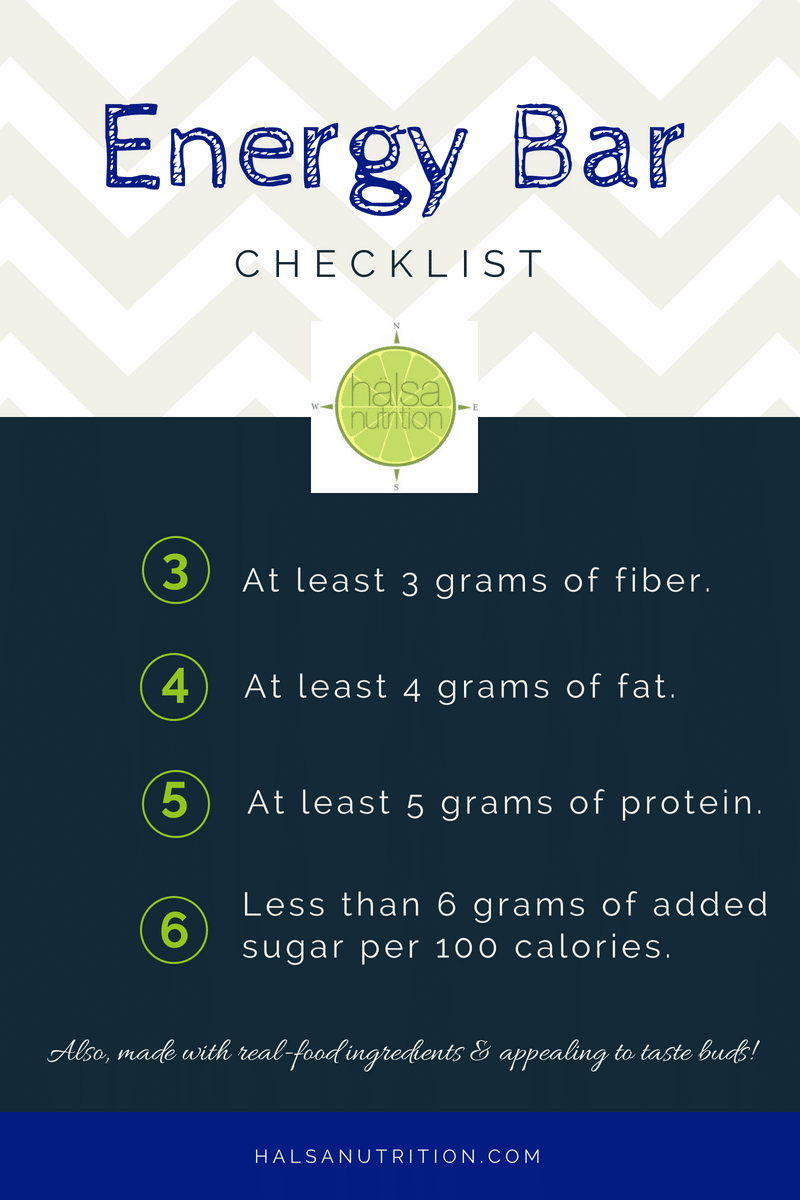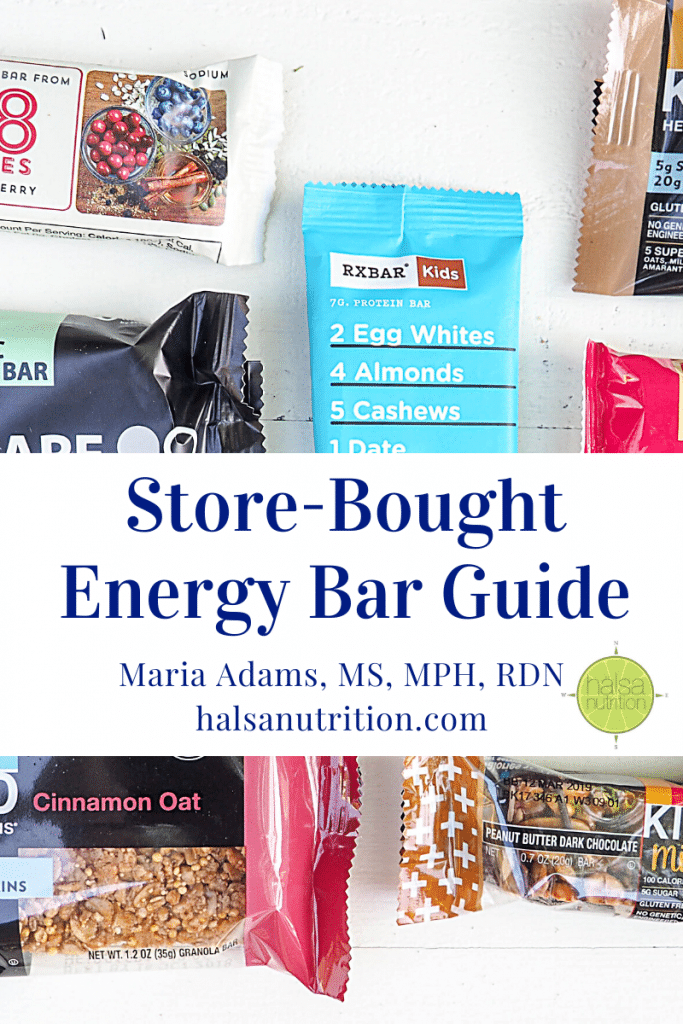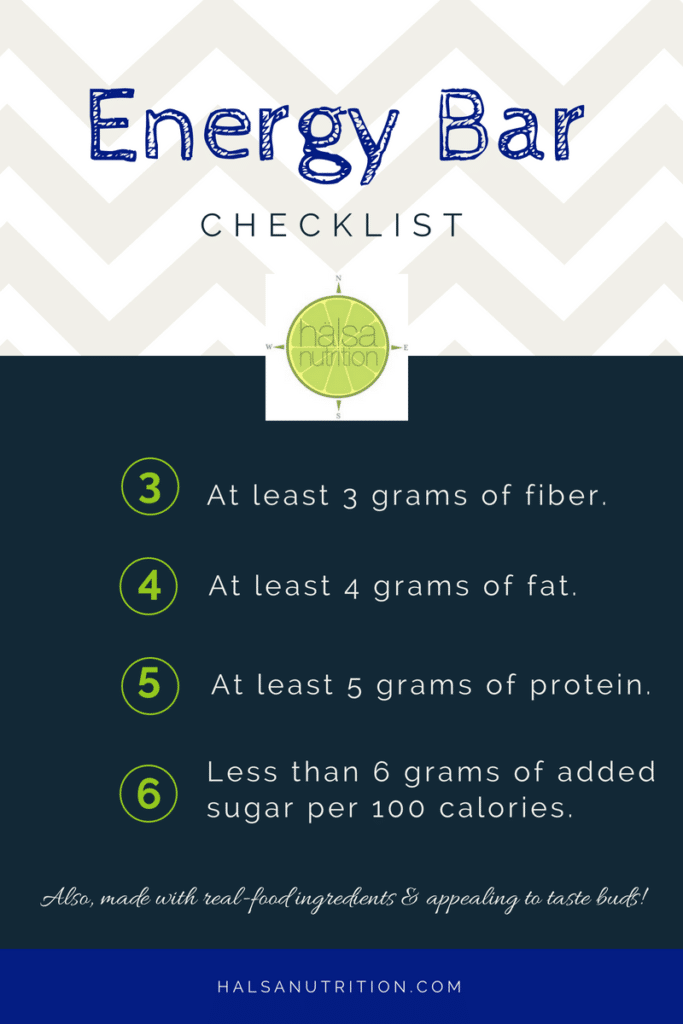
Store-Bought Energy Bar Guide
There are so many energy bars on the market these days. Which ones are best? What should you look for on the label? Read on to find out!
Energy Bars
Call them what you like: energy bars, granola bars, or protein bars. These little wrapped-up bars are portable and fuss-free, making them perfect for stashing in your bag for when hunger strikes.
But with so many options at the stores and online, it can be hard to know which ones to choose. So I’ve pulled together a guide on what to look for as well as a list of some of my favorite bars. This is by no means a comprehensive list, just a little mini-guide.
I recommend limiting energy bars to one serving a day on most days. When you are at home turn to other nourishing snack ideas such as:
- Banana with peanut butter,
- Plain Greek yogurt with fresh berries and hemp seeds,
- Almond milk chia pudding and berries,
- Whole wheat pita, veggies, and hummus,
- Soft-boiled egg with sweet potato toast, or
- Apple “donuts”!
You can also make your own energy bars and balls. There are so many recipes out there, including my no-bake granola bars, raspberry almond power bites, and coconut cashew bliss balls. Experiment with how much sugar you really need to make them healthy, and whenever possible get most of the sweetening from real foods such as Medjool dates, raisins, bananas, and applesauce.
Energy Bar Guide
What to Look for on the Label
- Real food ingredients:
- Nuts, seeds, dried fruit, oats, quinoa, millet, chia, dark chocolate, and natural cocoa
- Fiber:
- Ideally, at least 3 grams of fiber
- Added sugar (look for at least one of the following:)
- Less than 6 grams of added sugar per 100 calories
- Or the ratio of protein to sugar is about 1:1 (e.g., 10 g protein, 11 g sugar)
- Or sugar isn’t one of the top 2 ingredients
- Or Fiber grams + Protein grams = or > Sugar grams (F+P >S)
- Fat:
- Fat will help fill you up, ideally at least 4 grams per serving
- Protein:
- Adequate protein to help fill you up, ideally at least 5 grams of protein per serving
- But be wary of super high protein content as there may be non-natural sources of protein
- Natural protein sources include nuts, seeds, quinoa, whey powder, and pea powder
My Favorite Brands
Square – more sugar than many, but also very high protein — usually about a 1:1 ratio of protein to sugar GF DF V SF
88 Acres – some have more sugar than others, but in general very wholesome, and in my opinion very tasty! Plus, locally made in Boston! NF DF V GF SF
KIND Bars – healthy grain bars made with real ingredients; some of them have less sugar than others–the cinnamon oat bar has just 5 grams of sugar; they have a new high protein line—e.g., crunchy peanut butter has 12 grams of protein GF V
Lärabars – sugar comes from natural sources such as dates; also high in fiber and made with only a handful of real ingredients GF V
RxBar and RxBarKids– made with just 6 ingredients including nuts and dates plus egg whites for extra protein GF DF
Core food bars – made with 100% whole foods, all from plants; need to be refrigerated GF V
This bar saves lives – high in fiber, low in added sugar (plus every bar purchased helps feed a child in need!) GF K
Soul Sprout – raw, sprouted plant-based ingredients; example: coconut almond chocolate chip bar has 6 g protein and 3 g fiber V K
Abbreviation guide:
- GF = gluten-free
- DF = dairy-free
- V = vegan
- K = Kosher
- NF = nut-free
- SF = soy-free
Taste
Oh and make sure you like the taste! After all, how good is any food if you don’t enjoy eating it? Please don’t eat an energy bar “just because it’s healthy” if it tastes like cardboard to you. (Unless, of course, you are really hungry and it’s the only option!)
As you know, taste can be so individual. Out of the energy bars we sampled for this my favorite was the 88 Acres Dark Chocolate & Sea Salt. I also liked the Square bar a lot. My 11-year old loved the Mint Chip Brownie Lara Bar. And my whole family likes the KIND bars, so they are a staple at our house.
Cost
There is no doubt that granola and energy bars can be expensive. Look for deals and coupons, buy wholesale, and balance out with homemade bars and/or real food snacks.
Sugar Information
According to the American Heart Association:
- WOMEN should aim to consume 25 grams or less of added sugar per day. This translates into 6 teaspoons or less (1 teaspoon sugar = 4 grams sugar).
- MEN should aim to consume less than 38 grams of added sugar per day, or 9 teaspoons or less.
- KIDS ages 2-18 should consume no more than 6 teaspoons (25 grams) of added sugar per day and limit 8-ounce sugar-sweetened beverages to one per week. Experts recommend that kids under 2 should avoid added sugar.
Added sugar can take many forms, from classic table sugar to maple syrup to agave to brown rice syrup. Natural fruit sugar, such as that found in dates and bananas is better. See my article on sugar. While it’s good to limit added sugar, it would be unrealistic and unnecessary to completely avoid it.
Intuitive Eating Add-On
Finally, remember this is just a guide to help you find some nourishing products. Would I buy a granola bar that is high in sugar or has no protein but tastes good? Of course! It just probably wouldn’t be my everyday go-to. It’s all about mindful eating and finding that balance between pleasure and health.



Leave a Reply